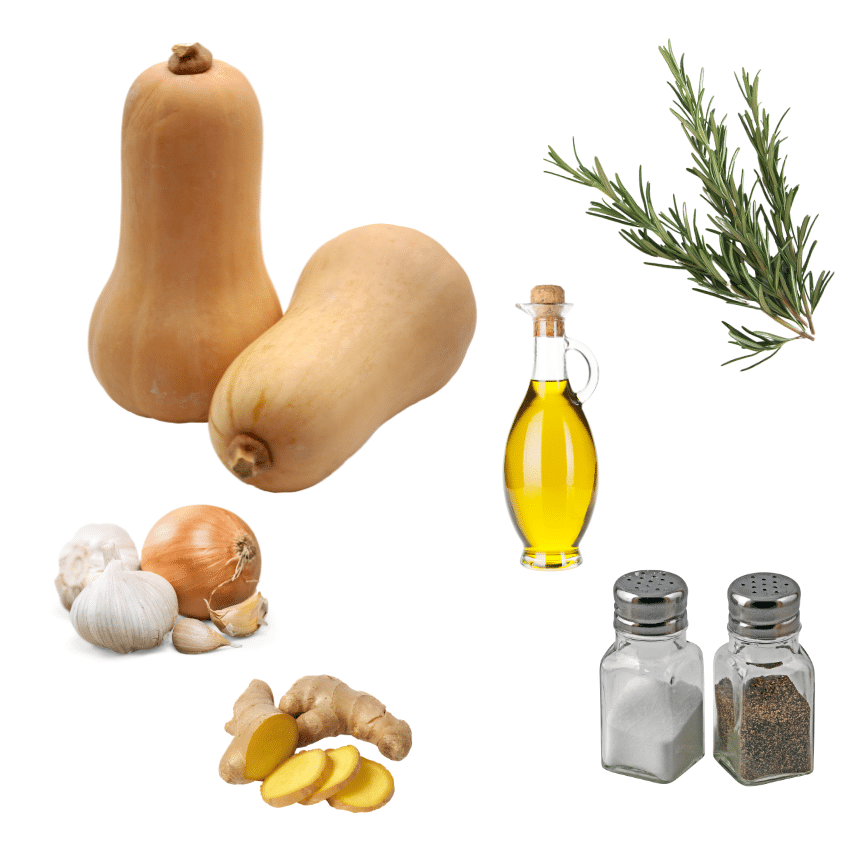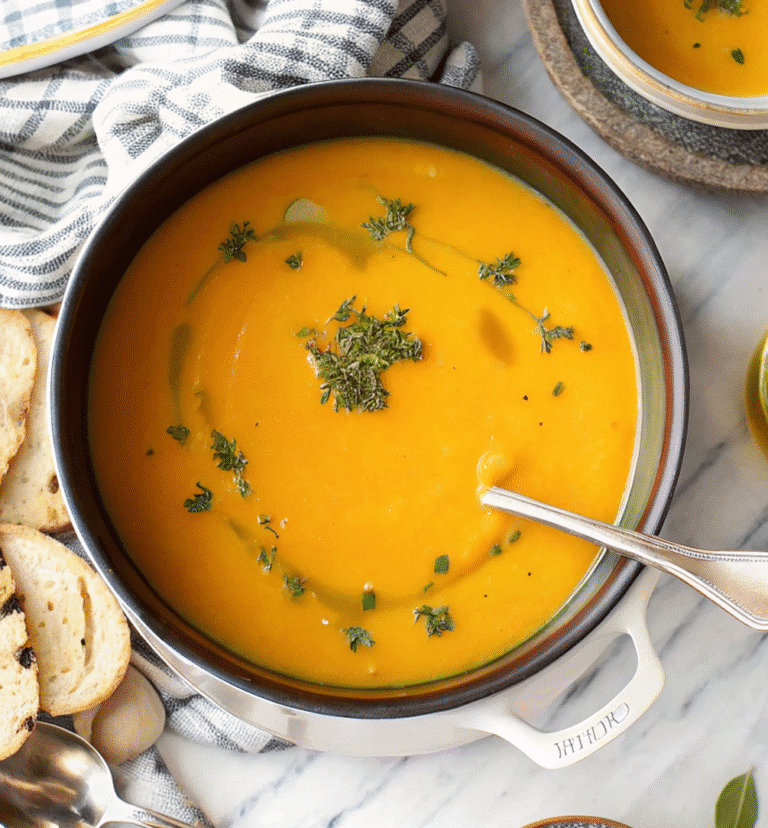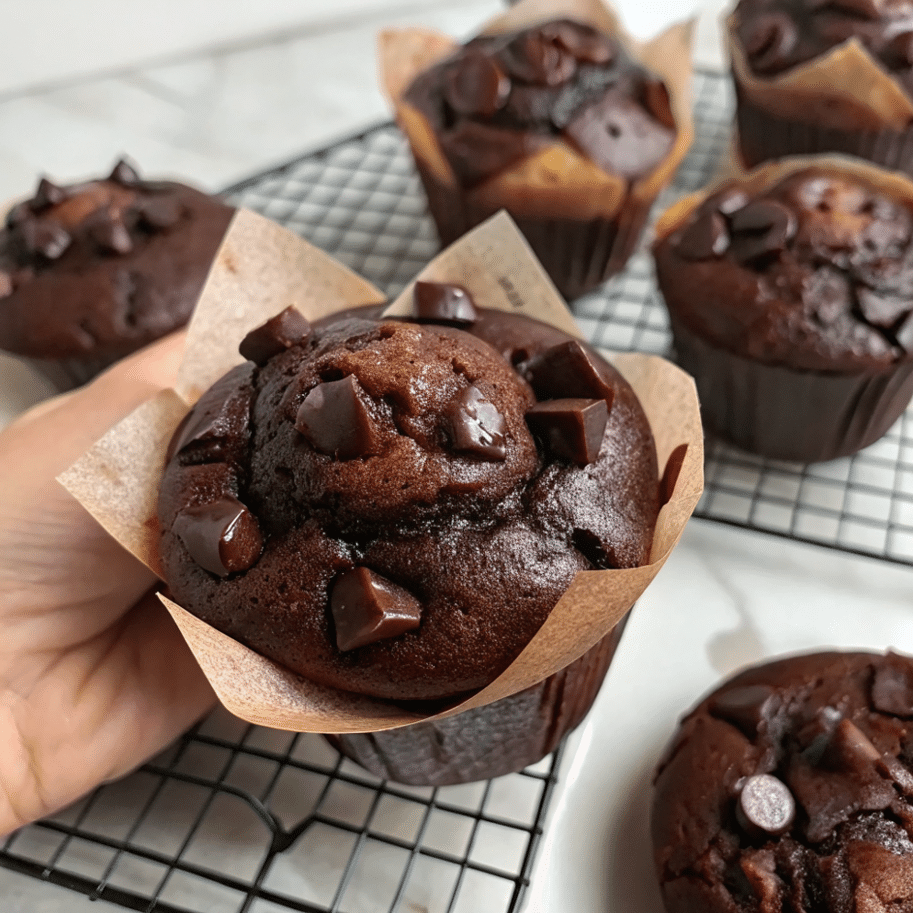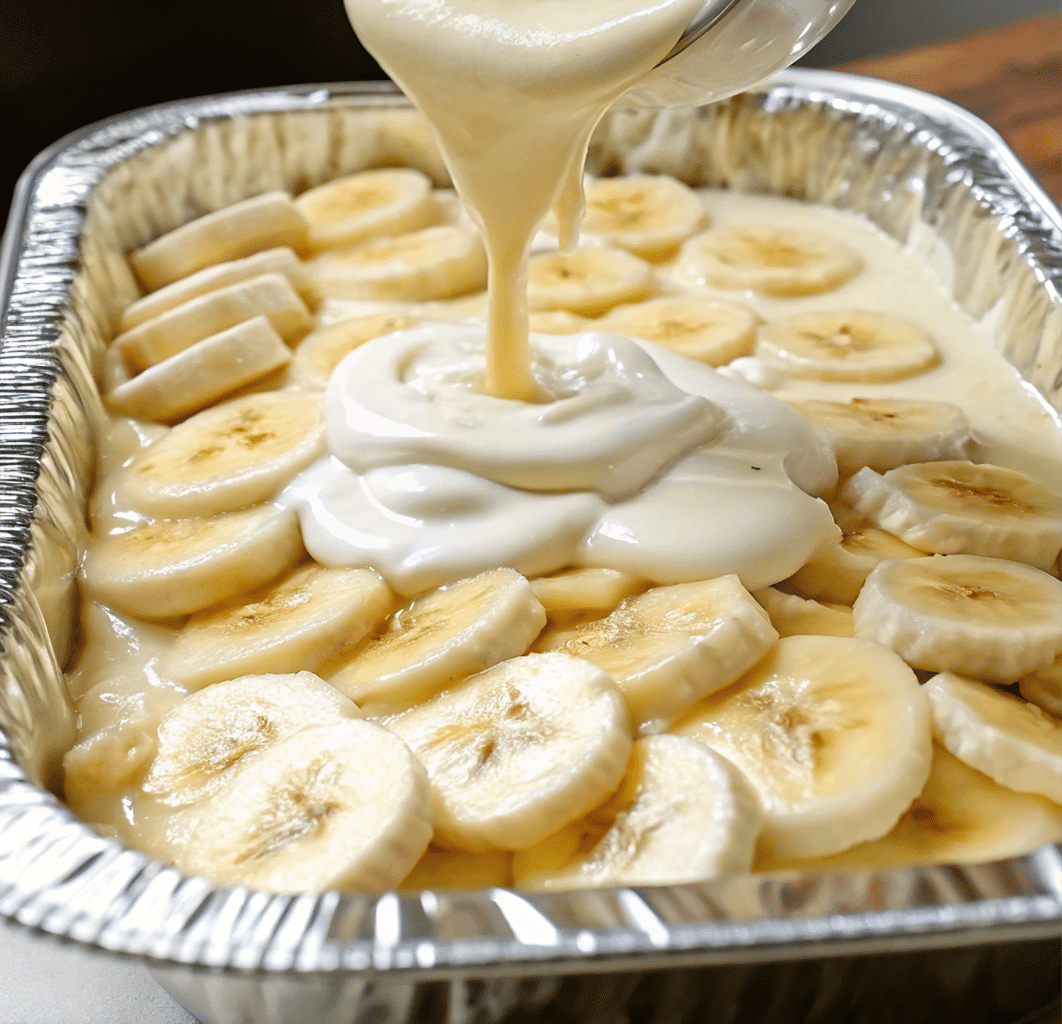When the air turns crisp and sweaters come out, there’s one comfort food that always hits the spot—butternut squash soup. Creamy, flavorful, and packed with nutrients, this warm bowl of goodness is the definition of cozy fall cooking. Whether you’re looking for a vegan weeknight dinner, a make-ahead meal prep option, or a dish to impress your guests, butternut squash soup delivers every time.

This blog post covers everything you need to know about making the perfect butternut squash soup from scratch. We’ll break down ingredients, cooking tips, what to mix with it, spice pairings, and whether you really need to peel that squash. We’ll even answer some of the most frequently asked questions, like how it compares to potatoes health-wise and the best ways to store leftovers.
Table of Contents
Don’t miss our creamy custard recipe for dessert after your savory bowl of soup. Now let’s dive into the heart of fall with this delicious dish.
Both vegetables are nutrient-dense and full of antioxidants, as highlighted in this in-depth comparison of orange vegetables, making them staples for immune health and gut support.
Butternut Squash Soup Overview: Why It’s a Seasonal Favorite
What Makes Butternut Squash Soup Special?
Butternut squash soup isn’t just another bowl of blended veggies—it’s an experience. The velvety texture, naturally sweet and nutty flavor, and bright golden color make it a stand-out favorite during fall and winter. What sets it apart from other soups is its versatility. You can keep it simple with just a few ingredients or dress it up with creative toppings and side pairings.
This soup is also extremely forgiving. Whether you’re a seasoned cook or just getting started in the kitchen, a successful batch of butternut squash soup is almost guaranteed. From stovetop to blender, it’s a breeze to whip up in under an hour.
Check out this easy one-pot taco spaghetti for another hearty meal idea.
Nutritional Benefits of Butternut Squash
Butternut squash isn’t just pretty on the outside—it’s packed with health perks too. A single serving is low in calories but rich in essential vitamins and minerals like:
| Nutrient | Benefit |
|---|---|
| Vitamin A | Supports eye health and immune system |
| Vitamin C | Boosts immunity and skin health |
| Potassium | Helps regulate blood pressure |
| Fiber | Aids digestion and promotes fullness |
| Magnesium | Supports muscle and nerve function |
It’s also a great source of antioxidants and beta-carotene, giving it that signature orange hue. For those trying to reduce carbs, butternut squash is a solid alternative to starchy veggies like potatoes.
Discover great ideas like this zucchini bread recipe for a wholesome pairing with your soup night.
Choosing the Right Ingredients for Your Butternut Squash Soup
Fresh vs Pre-Cut Squash: Which Is Better?
When it comes to the base of your soup, the type of butternut squash you choose makes a big difference. Fresh, whole squash delivers the deepest, most authentic flavor. It also tends to have better texture when cooked, which means a smoother, silkier soup once blended.
However, we get it—peeling and chopping butternut squash can be a pain. Pre-cut squash is a time-saver and still delivers solid results if you’re in a rush. Just make sure it’s fresh and not mushy. Avoid any pieces that are slimy or overly soft; they won’t caramelize well during sautéing and can water down the flavor.
If convenience is your top priority, frozen butternut squash cubes can work too, but expect a slightly different texture. They’re best used in soups where you don’t mind a thinner consistency.
Looking for inspiration? Try our homemade hotcakes recipe for a cozy breakfast to start your day.
Key Ingredients for Maximum Flavor

The best butternut squash soup recipes use a handful of thoughtfully chosen ingredients to build layers of taste. Here’s what you’ll need and why it matters:
- Extra-virgin olive oil: Adds richness and helps bring out the natural sweetness of squash.
- Yellow onion: Provides a base of savory depth. When sautéed, it adds umami and balances the sweetness.
- Garlic: Because everything is better with garlic—it adds punch and aroma.
- Fresh sage and rosemary: These earthy herbs are perfect for fall soups and bring a woodsy, comforting note.
- Fresh ginger: Adds subtle heat and brightness, cutting through the heaviness for balance.
- Vegetable broth: The liquid that binds it all together. Use a high-quality, low-sodium version so you can control the salt.
- Sea salt and pepper: To season, of course. Freshly ground black pepper adds a light kick.
If you’re feeling fancy, adding a splash of coconut milk or a spoonful of almond butter can create an even creamier finish without dairy.
Don’t miss our refreshing frozen jalapeño sauvignon blanc for a fun beverage pairing after your meal.
Step-by-Step Guide: How to Make Butternut Squash Soup
Tools and Equipment You Need
Before diving into the cooking process, having the right equipment on hand ensures everything goes smoothly from prep to plate. Here’s what you’ll need for a successful soup-making session:

- 5.5-Quart Dutch Oven: Ideal for even heat distribution and deep enough for simmering without spills. We love using the Staub Cocotte.
- Sharp Chef’s Knife: For slicing through tough squash skin with ease.
- Peeler: To strip away the tough outer layer—if you choose to peel it.
- Cutting Board: A stable, non-slip surface makes chopping safe and efficient.
- High-Speed Blender: A Vitamix or similar is perfect for pureeing the soup until silky smooth. You can also use an immersion blender for convenience.
Full Cooking Method with Pro Tips
Let’s walk through how to prepare a rich and creamy butternut squash soup from scratch. This method is tried-and-true and leaves plenty of room for your personal flair.
Ingredients (Serves 6)
- 2 tablespoons extra-virgin olive oil
- 1 large yellow onion, chopped
- ½ teaspoon sea salt
- 1 (3-pound) butternut squash, peeled, seeded, and cubed
- 3 garlic cloves, chopped
- 1 tablespoon chopped fresh sage
- ½ tablespoon minced fresh rosemary
- 1 teaspoon grated fresh ginger
- 3 to 4 cups vegetable broth
- Freshly ground black pepper to taste
For Garnish
- Chopped fresh parsley
- Toasted pepitas
- Crusty bread
Instructions
- Sauté the Base:
Heat olive oil in your Dutch oven over medium heat. Add chopped onion, sea salt, and several twists of black pepper. Cook for 5–8 minutes, stirring occasionally, until the onion is soft and fragrant. - Cook the Squash:
Add the cubed butternut squash and cook for another 8–10 minutes. Stir every few minutes so the squash softens and browns slightly. This step adds depth of flavor. - Layer in the Flavors:
Toss in the chopped garlic, sage, rosemary, and ginger. Stir for 30 seconds to a minute until the spices are aromatic. This is where the magic begins. - Simmer It Down:
Pour in 3 cups of vegetable broth and bring everything to a boil. Once boiling, reduce the heat, cover, and simmer for 20–30 minutes until the squash is fork-tender. - Blend Until Smooth:
Remove from heat and allow the soup to cool slightly. Transfer to a high-speed blender in batches, blending until silky smooth. If it’s too thick, add up to 1 more cup of broth. - Final Touches:
Taste and adjust seasoning. Ladle into bowls and top with parsley, toasted pepitas, and a slice of crusty bread.
Pro Tip:
If you’re meal-prepping, this soup stores wonderfully. It thickens slightly in the fridge, making it even creamier the next day.
Check out our elegant Dubai chocolate strawberries for a sweet finish to this fall feast.
What to Mix with Butternut Squash for Soup
Perfect Pairings: Fruits, Veggies, and Legumes
While butternut squash is delicious on its own, mixing it with the right ingredients can take your soup to the next level. Whether you want a richer flavor, smoother texture, or nutritional boost, here are excellent options that blend beautifully:
Vegetables
- Carrots: Their sweetness enhances the squash’s natural flavor.
- Sweet potatoes: Make your soup extra creamy and add a complex sweetness.
- Cauliflower: Lowers the overall carb content while keeping it velvety.
- Leeks or celery: For added depth and a savory kick.
Fruits
- Apples (especially Fuji or Honeycrisp): Add a sweet, crisp undertone that balances earthiness.
- Pears: For a lighter, floral sweetness perfect for fall flavors.
- Roasted pumpkin: A sibling squash that blends beautifully in texture and taste.
Legumes
- Red lentils: Cook quickly and add a plant-based protein boost.
- Chickpeas: Make the soup heartier and add thickness.
- White beans: Give a creamy, buttery consistency without cream.
These mix-ins can be added during the simmering stage, just after the squash has softened. If you want your soup ultra-smooth, blend them together. Prefer a little texture? Blend only part of the soup and stir the rest back in.
Don’t miss our recipe for banana bread latte—it pairs surprisingly well with squash soup for a cozy afternoon treat.
Best Plant-Based Mix-Ins for Richness
Want a creamier soup without using dairy? These ingredients are your best friends:
- Coconut milk: Adds lusciousness and a hint of tropical flavor.
- Almond butter or tahini: Introduce rich, nutty depth while keeping it vegan.
- Cashews: Soaked and blended, they thicken the soup and create an indulgent feel.
- Silken tofu: A protein-packed option that blends like a dream.
Use these with moderation to keep the squash flavor at the forefront, but don’t be afraid to experiment—each brings a new dimension to your bowl.
Seasoning Secrets: What Spices Go in Butternut Squash Soup?
Top Herbs and Spices That Enhance Flavor
The right spices can transform your butternut squash soup from simple to spectacular. They bring out the natural sweetness, add warmth, and build depth. Here are the must-have seasonings that make this dish truly sing:
Earthy & Aromatic Herbs
- Sage: Classic fall herb that pairs perfectly with squash. Its pine-like aroma deepens the flavor.
- Rosemary: Woody and robust, this herb adds warmth and complexity.
- Thyme: Subtle but flavorful, it adds a gentle herbal backbone.
- Essential Spices
- Cumin: Brings a smoky, nutty layer without overpowering.
- Nutmeg: Just a pinch can boost the sweetness and richness.
- Curry Powder: Adds a unique twist—great for those who like bold flavors.
- Cinnamon: Pairs beautifully with squash for a sweet-savory balance.
- Turmeric: Enhances color and brings anti-inflammatory properties.
These ingredients don’t just boost flavor—they also pack health benefits. For instance, turmeric and ginger (also used in our recipe) offer anti-inflammatory effects, while rosemary is known for antioxidant properties.
Discover more spice-enhanced ideas in our dense bean salad recipe that pairs flavor with health benefits.
Spice Blends to Match Different Taste Profiles
Depending on your mood or who you’re serving, try these different seasoning profiles to change up your soup:
| Flavor Style | Go-To Spices & Herbs |
|---|---|
| Classic Fall | Sage, rosemary, nutmeg, black pepper |
| Spicy & Bold | Curry powder, cayenne, cumin, chili flakes |
| Sweet & Savory | Cinnamon, clove, a touch of maple syrup |
| Global Fusion | Garam masala, ginger, turmeric, coriander |
Pro tip: Toast your dried spices in the oil before adding liquid. This activates the oils and maximizes flavor.
Looking for inspiration? Try our charcuterie nachos for a unique spicy snack that complements your soup night.
Skin Deep: Should You Peel Butternut Squash for Soup?
Benefits of Peeling vs Not Peeling
One of the most common questions people ask when preparing butternut squash soup is, “Do I really need to peel the squash?” The answer depends on the texture and cooking method you’re aiming for.
Why You Should Peel It:
- Smoother Texture: Peeling results in a silkier, more luxurious soup, especially when blended.
- No Chewy Bits: The skin doesn’t always break down fully when cooked, which can leave fibrous or gritty remnants in your bowl.
- Cleaner Flavor: Without the skin, the natural sweetness and nuttiness of the squash shine through.
When You Might Not Need to Peel:
- If You’re Roasting First: Roasted squash can be scooped from the skin after cooking, making peeling unnecessary upfront.
- High-Powered Blenders: If you own a Vitamix or Blendtec, the skin can be fully pulverized into the soup—but may still alter the texture.
- Organic Squash: When using organic produce, some people prefer to leave the skin on for the added fiber and nutrients.
Still, for soup, the safe bet is to peel it—especially if you’re serving guests or want a restaurant-quality finish.
Don’t miss our rich no-bake Boston cream cake recipe for dessert after your ultra-smooth soup.
Best Peeling and Prep Practices
If you’re ready to peel, here’s how to make the process painless:
Tools You’ll Need:
- Y-shaped vegetable peeler: Easier to grip and cuts more deeply.
- Sharp chef’s knife: Crucial for slicing through the squash.
- Sturdy cutting board: To keep everything stable and safe.
👣 Step-by-Step Prep:
- Slice off both ends of the squash to create flat surfaces.
- Use your peeler to strip away the skin in long, even strokes.
- Cut the squash in half lengthwise, scoop out the seeds, then chop into uniform cubes.
Pro Tip: Microwave the whole squash for 1–2 minutes before peeling to slightly soften the skin—making peeling way easier.
Butternut Squash vs Potatoes: Which Is Healthier?
Nutrition Comparison Table: Squash vs Potatoes
If you’re wondering whether butternut squash is a healthier choice than potatoes, the answer depends on your dietary goals. However, when it comes to soups—especially plant-based ones—butternut squash usually wins in the nutrition department.
Here’s a head-to-head breakdown per 1-cup cooked serving:
| Nutrient | Butternut Squash | White Potato |
|---|---|---|
| Calories | 82 | 130 |
| Carbohydrates | 22 g | 30 g |
| Fiber | 6.6 g | 2.2 g |
| Sugar (natural) | 4 g | 1.2 g |
| Vitamin A | 457% DV | 0% DV |
| Vitamin C | 52% DV | 28% DV |
| Potassium | 582 mg | 610 mg |
| Glycemic Index | Low | Medium-High |
What the Table Tells Us:
- Lower in Calories & Carbs: Butternut squash has fewer calories and carbohydrates than potatoes, making it better for those watching weight or managing blood sugar.
- Higher in Fiber: This improves digestion and increases satiety.
- Vitamins Galore: Butternut squash is a powerhouse for Vitamin A and provides nearly double the Vitamin C of potatoes.
- Lower Glycemic Load: It won’t spike your blood sugar like white potatoes can.
Looking for another nutrient-rich dish? Don’t miss our cottage cheese banana bread—a protein-packed baked good that’s surprisingly healthy.
Health Benefits and Use Cases of Each
Butternut Squash Benefits:
- Supports eye health and immune function due to its high beta-carotene.
- Better suited for low-glycemic diets and plant-based meal plans.
- Naturally sweet, so you can avoid added sugars in your soup.
Potato Perks:
- Great energy source due to complex carbs.
- Useful in recipes requiring a thicker, starchier texture.
- Widely available and more filling in certain dishes.
While both have their place, butternut squash is the better option if you’re looking to lighten up your meals without compromising on taste or texture.
Storage, Freezing & Reheating Tips for Butternut Squash Soup
How to Store Soup in the Fridge or Freezer
One of the best things about butternut squash soup—besides its cozy flavor—is that it stores beautifully. Whether you’re meal prepping or saving leftovers, here’s how to do it right.
In the Fridge:
- Cool completely before transferring to containers. Hot soup can raise the temperature inside your fridge and spoil other food.
- Use airtight glass or BPA-free plastic containers.
- Store up to 4 days in the refrigerator. Beyond that, quality starts to drop.
In the Freezer:
- Use freezer-safe containers or resealable freezer bags.
- Lay bags flat to save space and help them freeze evenly.
- Label with the date so you know when to use it by.
- Freeze for up to 3 months. Longer is possible, but flavor and texture may decline.
Discover great ideas like our foil pack ravioli for other make-ahead meal inspiration.
How to Reheat Without Losing Flavor or Texture
Reheating butternut squash soup is easy, but doing it right makes all the difference between a smooth, flavorful bowl and a clumpy, dull one.
Stovetop Method:
- Pour soup into a pot.
- Reheat slowly over medium-low heat, stirring occasionally.
- Add a splash of broth or water if the soup is too thick.
Microwave Method:
- Place soup in a microwave-safe bowl.
- Cover loosely with a lid or paper towel to prevent splattering.
- Heat in 1-minute increments, stirring in between, until warmed through.
Pro Tips:
- Never boil your soup when reheating—it can separate or dull the flavor.
- Taste and adjust seasoning after reheating. A pinch of salt or squeeze of lemon can reawaken the flavors.
Don’t miss our pickle lemonade—yes, seriously—for a zesty, palate-cleansing drink after a warm soup lunch.
Best Toppings & Serving Ideas for Butternut Squash Soup
Creative Garnishes and Texture Boosters
The smooth, velvety texture of butternut squash soup is a blank canvas for bold garnishes. Toppings add crunch, creaminess, color, and extra flavor. Here are some favorites:
Fresh Herbs
- Chopped parsley: Adds freshness and color contrast.
- Chives or green onions: A mild oniony kick.
- Cilantro: Bright and citrusy—great if your soup includes chili or curry flavors.
Crunchy Add-Ons
- Toasted pepitas: Pumpkin seeds add nuttiness and crunch. Try spiced or salted versions.
- Roasted chickpeas: For a protein-rich, crispy bite.
- Croutons: Homemade or store-bought, they bring satisfying texture to every spoonful.
Creamy Drizzles
- Coconut milk or cream: Swirl on top for visual appeal and richness.
- Cashew cream: A dairy-free alternative to heavy cream.
- Yogurt (plant-based or regular): A tangy contrast that balances sweetness.
Check out our cottage cheese cookie dough for a surprisingly healthy dessert to finish your soup dinner with a twist.
Perfect Side Dishes and Bread Pairings
Pair your butternut squash soup with the right sides, and you’ve got yourself a complete, cozy meal.
Bread Favorites:
- Crusty sourdough: Great for dipping and soaking up soup.
- Garlic toast: Adds a savory edge and crisp bite.
- Grilled naan: Especially delicious with curry-spiced variations of this soup.
Light Sides:
- Mixed greens with vinaigrette: Balances the richness of the soup.
- Roasted Brussels sprouts or root veggies: Keep it in the fall theme.
- Stuffed mushrooms: Great for when you want a slightly fancier spread.
For a balanced meal, try pairing your soup with our heirloom tomato flight—a colorful, fresh companion on your fall table.
Frequently Asked Questions (FAQ)
What to mix with butternut squash for soup?
You can mix butternut squash with carrots, apples, sweet potatoes, white beans, or coconut milk for extra creaminess. Spices like sage, rosemary, and ginger bring out the flavor, while red lentils or cashews can thicken it naturally and add protein.
Is butternut squash healthier than potatoes?
Yes. Butternut squash is generally lower in calories and carbs while providing more fiber, vitamin A, and antioxidants than potatoes. It’s also a better choice for low-glycemic diets and plant-based eaters.
What spices go into butternut squash soup?
Popular spices include sage, rosemary, cumin, cinnamon, ginger, nutmeg, and turmeric. These spices enhance the natural sweetness of the squash while building a warm, savory flavor base.
Do I peel butternut squash to make soup?
Yes, for the smoothest texture, it’s best to peel the squash. The skin can be tough and fibrous. However, if roasting first, you can scoop out the flesh afterward and skip peeling altogether.
Why Butternut Squash Soup Deserves a Spot in Your Fall Menu
Butternut squash soup isn’t just a comfort food—it’s an experience. Its rich flavor, creamy texture, and vibrant color make it a must-have for any fall or winter table. Whether you’re preparing it for weeknight dinners, holiday gatherings, or meal prep, this soup delivers warmth, nutrition, and pure satisfaction.
With endless mix-in options, spice pairings, and toppings, you can reinvent this dish each time you make it. And best of all, it stores well, freezes beautifully, and reheats like a dream. Cozy, nourishing, and endlessly versatile—butternut squash soup is here to stay.
Don’t miss our homemade yeast rolls to round out your meal with the ultimate dipping bread.
Print
Butternut Squash Soup: The Best Cozy Fall Recipe You’ll Ever Make
Butternut Squash Soup is the ultimate cozy fall recipe—smooth, creamy, and rich in flavor. Roasted squash blended with garlic, onion, and warming spices creates a comforting bowl perfect for chilly evenings, holiday meals, or make-ahead lunches.
- Total Time: 45 minutes
- Yield: 6 servings
Ingredients
1 large butternut squash (about 2.5–3 lbs), peeled and cubed
2 tablespoons olive oil
1 medium onion, chopped
3 cloves garlic, minced
4 cups vegetable broth
1/2 teaspoon ground cinnamon
1/4 teaspoon ground nutmeg
1/2 cup coconut milk or heavy cream
Salt and pepper to taste
Optional toppings: roasted pumpkin seeds, Greek yogurt, or fresh herbs
Instructions
1. Preheat oven to 400°F. Toss cubed butternut squash with 1 tablespoon olive oil, salt, and pepper. Spread on a baking sheet and roast for 25–30 minutes, until tender and caramelized.
2. In a large pot, heat remaining olive oil over medium heat. Sauté onion until soft, about 5 minutes. Add garlic and cook for 1 minute.
3. Add roasted squash, cinnamon, nutmeg, and vegetable broth. Stir to combine.
4. Bring to a simmer, then cover and cook for 10 minutes to let flavors meld.
5. Use an immersion blender to puree the soup until smooth (or blend in batches in a blender).
6. Stir in coconut milk or cream. Taste and adjust seasoning.
7. Serve hot, topped with pumpkin seeds, herbs, or a swirl of yogurt.
Notes
Make it vegan with coconut milk or keep it rich with heavy cream.
Freeze leftovers for up to 2 months.
Roasting the squash enhances flavor—don’t skip that step!
- Prep Time: 15 minutes
- Cook Time: 30 minutes
- Category: Soup / Fall Favorites
- Method: Roasted / Blended
- Cuisine: American




